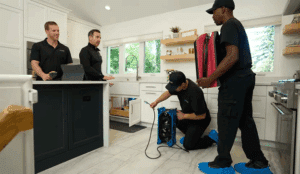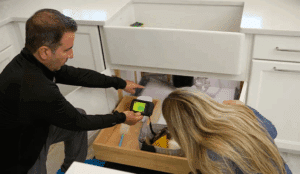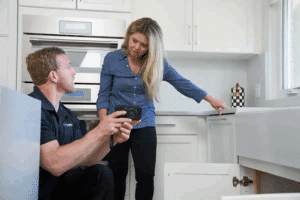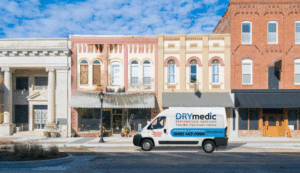Your Florida home needs immediate attention after a flood hits. Mold can start growing on wet surfaces within 24-48 hours in our state’s notorious humid climate. The post-flood environment creates perfect conditions that allow mold to thrive rapidly.
Standing water combined with Florida’s high humidity creates the perfect environment for aggressive mold growth. Even a small water intrusion can quickly turn into a serious mold problem, as we’ve seen many times. An effective flood damage prevention plan should include immediate water extraction, thorough drying, and professional dehumidification services.
Many homeowners don’t realize that their insurance may cover professional remediation. DRYmedic knows that timely mold prevention not only protects your property’s value but also safeguards your family’s health and wellbeing.
Table of Contents
-
What to Do Immediately After a Flood to Stop Mold
-
How to Clean and Dry Your Home the Right Way
-
Long-Term Mold Prevention in Florida’s Humid Climate
-
Conclusion
-
FAQs
This piece offers a complete guide to prevent mold growth after flooding, specifically designed for Florida’s unique climate challenges. You’ll learn everything needed to keep your home dry and mold-free, from emergency response tactics to lasting prevention strategies.

What to Do Immediately After a Flood to Stop Mold
Your home’s clock starts ticking the moment floodwater enters. Quick action stops mold from taking hold in your property. Time becomes your most critical resource to prevent flood damage in Florida. Safety should be your priority. Turn off electricity at the main breaker if water reaches electrical outlets. Put on protective gear – gloves, boots, and masks before you enter flooded areas. Get rid of standing water fast with pumps or wet vacuums. Mops and towels can help absorb moisture from smaller floods. Move your water-damaged furniture and belongings to a dry area with good ventilation.
Take out soaked materials that you can’t save right away. Carpeting, padding, and damaged drywall become perfect spots for mold to grow within hours in Florida’s humidity. Let air flow through space. Open windows if outside humidity stays lower than inside and place fans at strategic spots to move air around.
Industrial dehumidifiers extract moisture from walls, floors, and air – you need these in our humid climate. Professional equipment makes a big difference to prevent flood damage. DIY efforts often fall short to stop mold growth, especially given our state’s tough environmental conditions. The first 24 hours give you the best chance to stop a minor flood from turning into a serious mold issue. Act now.
How to Clean and Dry Your Home the Right Way
The right cleaning techniques can make all the difference between a fully restored home and one that struggles with ongoing mold problems. Standing water removal should be your first priority, followed by a deep clean to prevent flood damage.

You’ll need to gather several cleaning supplies: non-ammonia detergent, disinfectant, buckets, brushes, and heavy-duty gloves. A thorough cleaning with detergent and water should cover all surfaces that floodwater touches. The next step involves disinfecting with a mixture of one cup bleach to five gallons of water. Remember – mixing cleaning chemicals creates dangerous fumes, so avoid it completely.
Your drying efforts will work better with professional-grade equipment. Standard fans can’t compete with industrial air movers that create powerful circulation when placed strategically. Commercial dehumidifiers also work faster than household units to pull moisture from the air. Your walls and flooring need constant moisture monitoring while they dry. Many insurance policies that cover flood damage prevention will pay for professional moisture testing. This service helps detect hidden dampness that often goes unnoticed.
The drying process needs patience to work properly. Any rush at this stage will lead to mold problems later. Dehumidification should continue until all materials show normal moisture readings – this usually takes 48-72 hours minimum, based on humidity levels. Your furniture, clothing, and other salvageable items need proper cleaning and drying too. This prevents them from becoming sources of mold growth down the line.
Long-Term Mold Prevention in Florida’s Humid Climate
Surviving a flood is just the start. Your biggest challenge comes from keeping your Florida home mold-free during humid seasons. Florida homeowners need effective strategies to protect against mold coming back. Your most powerful defense against flood damage starts with indoor humidity control after the original cleanup.
Indoor humidity should stay between 30-50% – tough but doable in Florida. Whole-house dehumidifiers work better than portable units by a lot, especially when you have to deal with our muggy summer months.

Your AC system stands as your first defense against humidity, making HVAC maintenance a vital part of stopping mold long-term. Many homeowners don’t realize their air conditioning systems help control moisture while cooling their homes. Regular professional service will give a properly working system that removes moisture effectively.
Smart homeowners install moisture-resistant materials during repairs. Water-resistant drywall, mold-inhibiting paints, and tile flooring protect better against future mold growth.
These upgrades often qualify for flood damage prevention insurance coverage, making them cheaper than you might expect.Bathrooms, kitchens, and laundry areas need proper ventilation. Exhaust fans must vent directly outdoors instead of attic spaces where moisture gets trapped. DRYmedic team has developed specialized restoration techniques that work well with Florida’s unique climate challenges. Our experience shows that regular maintenance and proactive care help homeowners avoid costly remediation down the line.
Conclusion
Florida’s persistent humidity creates unique challenges when dealing with flood damage. Quick action in the first 24-48 hours serves as your best defense against mold infestation. Moisture control remains the life-blood of effective mold prevention during Florida’s warm seasons. Safety should be your priority after a flood. Water removal and professional-grade drying techniques must follow immediately. Many homeowners don’t realize how fast mold grows in our climate. Our team has seen simple flooding turn into major remediation projects because people waited too long.

Proper cleaning needs more than surface treatments. Your disinfection must reach all affected areas, and moisture monitoring will give a complete picture of what lies beneath seemingly dry surfaces. Your risk of future mold problems drops substantially when you keep indoor humidity between 30 and 50%.
Florida’s climate turns mold prevention into an ongoing challenge rather than a one-time task. In spite of that, you can protect your property value and family’s health with the right knowledge and quick response. Professional equipment, specialized techniques, and climate-specific strategies make the difference in our unique environment.
FAQs
How quickly should I act to prevent mold growth after a flood in Florida?
You should act immediately, within 24-48 hours after flooding occurs. In Florida’s humid climate, this timeframe is critical to prevent mold from colonizing wet surfaces in your home.
What’s the ideal indoor humidity level to prevent mold growth in Florida?
Maintain indoor humidity between 30-50%. This range is challenging but achievable in Florida’s climate and significantly reduces the risk of mold growth in your home.
What are some effective ways to dry out a flooded home?
Use industrial air movers and dehumidifiers to create powerful air circulation and extract moisture. Open windows if outside humidity is lower than inside, and continue the drying process for at least 48-72 hours, depending on humidity conditions.
How can I disinfect surfaces after a flood to prevent mold?
Clean all surfaces touched by floodwater with non-ammonia detergent and water. Then, disinfect using a solution of one cup bleach to five gallons of water. Never mix cleaning chemicals as this can create dangerous fumes.
What long-term strategies can I implement to prevent mold in Florida’s humid climate?
Consider installing whole-house dehumidifiers, maintain your HVAC system regularly, use moisture-resistant building materials during repairs, ensure proper ventilation in high-moisture areas, and monitor indoor humidity levels consistently.
Stop Mold Before It Spreads After a Flood
→ Practical steps to control moisture and protect your home in Florida’s humid climate
→ Proven restoration strategies that reduce health risks and long-term damage
→ Expert guidance to keep your property safe, dry, and mold-free
Take control of your home’s recovery—learn how to prevent mold growth after flooding today →
★★★★★ Rated 5/5 by 26 homeowners for reliable restoration services.